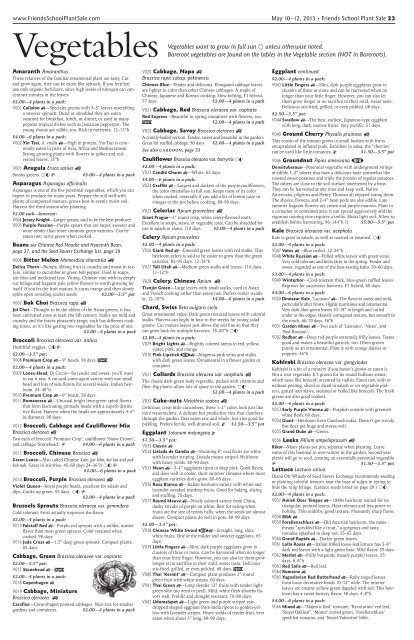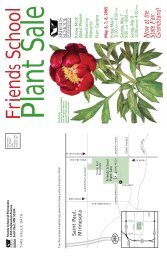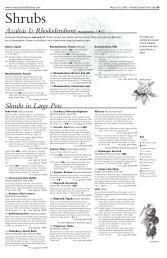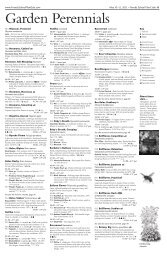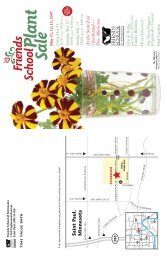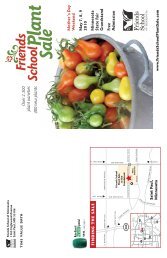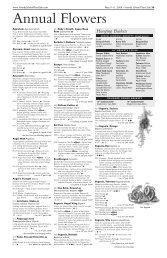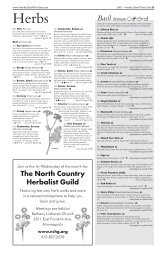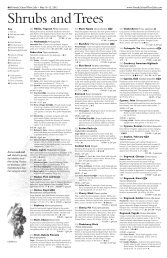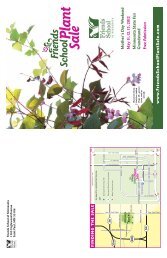Vegetables - Friends School Plant Sale
Vegetables - Friends School Plant Sale
Vegetables - Friends School Plant Sale
You also want an ePaper? Increase the reach of your titles
YUMPU automatically turns print PDFs into web optimized ePapers that Google loves.
www.<strong>Friends</strong><strong>School</strong><strong>Plant</strong><strong>Sale</strong>.com May 10–12, 2013 • <strong>Friends</strong> <strong>School</strong> <strong>Plant</strong> <strong>Sale</strong> 23<br />
<strong>Vegetables</strong><br />
<strong>Vegetables</strong> want to grow in full sun Í unless otherwise noted.<br />
Bareroot vegetables are found on the tables in the Vegetable section (NOT in Bareroots).<br />
Amaranth Amaranthus<br />
These relatives of the familiar ornamental plant are tasty. Cut<br />
and grow again, they can be eaten like spinach. If you fertilize,<br />
use only organic fertilizers, since high levels of nitrogen can concentrate<br />
nitrates in the leaves.<br />
$2.00—4 plants in a pack:<br />
V001 Callaloo ß—Specialty greens with 3–5” leaves resembling<br />
a sweeter spinach. Diced or shredded they are eaten<br />
steamed for breakfast, lunch, or dinner, or used in many<br />
popular tropical dishes such as Jamaican pepperpot. The<br />
young shoots are edible, too. Rich in nutrients. 12–15”h<br />
$4.00—6 plants in a pack:<br />
V002 Yin Tsai, A. viridis ß—High in protein, Yin Tsai is commonly<br />
eaten in parts of Asia, Africa and Mediterranean.<br />
Strong growing plants with flowers in spikes and redveined<br />
leaves. 15”h<br />
V003 Arugula Eruca sativa ß<br />
Smoky greens. Í∏ ´<br />
$3.00—4 plants in a pack<br />
Asparagus Asparagus officinalis<br />
Asparagus is one of the few perennial vegetables, which you can<br />
expect to produce for many years. Prepare the soil well with<br />
plenty of composted manure; grows best in evenly moist soil.<br />
Harvest the third season after planting.<br />
$2.00 each—bareroot:<br />
V004 Jersey Knight—Larger spears; said to be the best producer.<br />
V005 Purple Passion—Purple spears that are larger, sweeter and<br />
more tender than more common green varieties. Can be<br />
eaten raw; turns green when cooked.<br />
Beans see Chinese Red Noodle and Hyacinth Bean,<br />
page 27, and the Seed Savers Exchange list, page 29<br />
V006 Bitter Melon Momordica charantia ß<br />
Delica Thorn—Bumpy, oblong fruit is crunchy and moist in texture,<br />
similar to cucumber or green bell pepper. Used in soups,<br />
stir fries and medicinal teas. Vining. Chinese vine with its deeply<br />
cut foliage and fragrant pale yellow flowers is worth growing for<br />
itself. If you let the fruit mature, it turns orange and then slowly<br />
splits open revealing scarlet seeds.<br />
$2.00—3.5” pot<br />
V007 Bok Choi Brassica rapa ß<br />
Joi Choi—Thought to be the oldest of the Asian greens, it has<br />
been cultivated since at least the 5th century. Stalks are mild and<br />
crunchy and the leaves pleasantly tangy; each has different cooking<br />
times, so it’s like getting two vegetables for the price of one.<br />
$2.00—4 plants in a pack<br />
Broccoli Brassica oleracea var. italica<br />
Healthful veggies. 긫<br />
$2.00—3.5” pot:<br />
V008 Premium Crop ß—9” heads. 58 days. Ø<br />
$2.00—4 plants in a pack:<br />
V009 Loose-Head, Di Ciccio—So tender and sweet, you’ll want<br />
to eat it raw. A cut-and-come-again variety with one small<br />
head and lots of side florets for several weeks. Italian heirloom.<br />
24–48”h<br />
V010 Premium Crop ß—9” heads. 58 days.<br />
V011 Romanesco ß—Unusual bright lime-green spiral florets<br />
that form fascinating pinnacle heads with a superb distinctive<br />
flavor. Harvest when the heads are approximately 4–6”<br />
in diameter. 90 days.<br />
V012 Broccoli, Cabbage and Cauliflower Mix<br />
Brassica oleracea ß<br />
Two each of broccoli ‘Premium Crop’, cauliflower ‘Snow Crown’,<br />
and cabbage ‘Stonehead’. ´ $4.00—6 plants in a pack<br />
V013 Broccoli, Chinese Brassica ß<br />
Green Lance—Also called Chinese kale, gai lohn, kai lan and pak<br />
kah nah. Great in stir-fries. 45–60 days 24–36”h Í∏ ´<br />
$4.00—6 plants in a pack<br />
V014 Broccoli, Purple Brassica oleracea ß<br />
Violet Queen—Royal purple heads, excellent for salads and<br />
dips. Cooks up green. 55 days. Í∏ ´<br />
$2.00—4 plants in a pack<br />
Brussels Sprouts Brassica oleracea var. gemmifera<br />
Cold-tolerant: Frost actually improves the flavor.<br />
$2.00—4 plants in a pack:<br />
V015 Falstaff Red ß—Purple-red sprouts with a milder, nuttier<br />
flavor than most green sprouts. Color retained when<br />
cooked. 98 days<br />
V016 Jade Cross ß—1.5” deep green sprouts. Compact plants.<br />
85 days.<br />
Cabbage, Green Brassica oleracea var. capitata<br />
$2.00—3.5” pot:<br />
V017 Stonehead ß—Ø<br />
$2.00—4 plants in a pack:<br />
V018 Copenhagen ß<br />
V019 Cabbage, Miniature<br />
Brassica oleracea ß<br />
Caraflex—Cone-shaped pointed cabbages. Nice size for smaller<br />
gardens and containers.<br />
$2.00—4 plants in a pack<br />
V020 Cabbage, Napa ß<br />
Brassica rapa subsp. pekinensis<br />
Chinese Blue—Tender and delicious. Elongated cabbage leaves<br />
are lighter in color than other Chinese cabbages. A staple of<br />
Chinese, Japanese and Korean cooking. Slow bolting, F1 hybrid.<br />
57 days. $2.00—4 plants in a pack<br />
V021 Cabbage, Red Brassica oleracea var. capitata<br />
Red Express—Beautiful in spring containers with flowers, too.<br />
Ø<br />
$2.00—4 plants in a pack<br />
V022 Cabbage, Savoy Brassica oleracea ß<br />
A crinkly-leafed version. Tender, sweet and beautiful in the garden.<br />
Great for stuffed cabbage. 90 days $2.00—4 plants in a pack<br />
See also CARDOON, page 33<br />
Cauliflower Brassica oleracea var. botryrtis Í∏<br />
$2.00—4 plants in a pack:<br />
V023 Candid Charm ß—White. 65 days.<br />
$4.00—6 plants in a pack:<br />
V024 Graffiti ß—Largest and darkest of the purple cauliflowers,<br />
the color intensifies in full sun. Keeps most of its color<br />
when cooked, especially if you add a bit of lemon juice or<br />
vinegar to the pot before cooking. 80–90 days.<br />
V025 Celeriac Apium graveolens ß<br />
Giant Prague—5” round crisp, white celery-flavored roots.<br />
Excellent in soups, stews, or vegetable juice. Can be shredded for<br />
use in salads or slaws. 110 days. $2.00—4 plants in a pack<br />
Celery Apium graveolens<br />
$2.00—4 plants in a pack:<br />
V026 Giant Red ß—Emerald green leaves with red stalks. This<br />
heirloom celery is said to be easier to grow than the green<br />
varieties. 85–95 days. 12–18”h<br />
V027 Tall Utah ß—Medium green stalks and leaves. 110 days.<br />
11–12”h<br />
V028 Celery, Chinese Apium ß<br />
Tianjin Green—Large leaves with small stalks, used in Asian<br />
and French cooking rather than eaten raw. Prefers cooler weather.<br />
12–18”h<br />
$4.00—6 plants in a pack<br />
Chard, Swiss Beta vulgaris cicla<br />
Great ornamental value. Dark green textured leaves with colorful<br />
stalks. Harvest can begin in four to five weeks for young salad<br />
greens. Cut mature leaves just above the soil line so that they<br />
can grow back for multiple harvests. 18–20”h Í∏<br />
$2.00—4 plants in a pack:<br />
V029 Bright Lights ß—Brightly colored stems in red, yellow,<br />
violet, pink, and orange.<br />
V030 Pink Lipstick ◊ß—Magenta-pink veins and stalks<br />
with dark green leaves. Ornamental in a flower garden or<br />
container.<br />
V031 Collards Brassica oleracea var. acephala ß<br />
The classic dark-green leafy vegetable, packed with vitamins and<br />
fiber. Big plants: allow lots of space in the garden. Í∏<br />
$2.00—4 plants in a pack<br />
V032 Cuke-nuts Melothria scabra ß<br />
Delicious, crisp little cucumbers, these 1–2” cukes look just like<br />
mini watermelons. A delicate but productive vine that clambers<br />
through the garden. Best eaten raw and whole, but also good for<br />
pickling. Prefers fertile, well-drained soil. † $1.50—3.5” pot<br />
Eggplant Solanum melongena †<br />
$1.50—3.5” pot:<br />
V033 Classic ß<br />
V034 Listada de Gandia ß—Stunning 8” oval fruits are white<br />
with lavender striping. Listada means striped. Heirloom<br />
with heavy yields. 80–90 days<br />
V035 Neon ß—3–4” eggplants ripen to deep pink. Good flavor,<br />
and does well in cooler, short summer climates where most<br />
eggplant varieties don’t grow. 60–65 days.<br />
V036 Rosa Bianco ß—Italian heirloom variety with white and<br />
lavender streaked teardrop fruits. Good for baking, slicing<br />
and stuffing. 75 days.<br />
V037 Round Mauve ß—Nicely colored variety from China,<br />
dusky streaks of purple on white. Best for eating when<br />
fruits are the size of tennis balls, when the seeds are almost<br />
absent. Compact plants do well in pots. 80–90 days<br />
$2.00—3.5” pot:<br />
V038 Chinese White Sword ◊ß—Straight, long, thin,<br />
white fruits. One of the milder and sweeter eggplants. 65<br />
days.<br />
V039 Little Fingers ß—Slim, dark purple eggplants grow in<br />
clusters of three or more. Can be harvested when no longer<br />
than your little finger. However, you can also let them grow<br />
longer at no sacrifice to their mild, sweet taste. Delicious<br />
stir-fried, grilled, or even pickled. 68 days. Ø<br />
V040 Thai ‘Kermit’ ß—Compact plant produces 2” round<br />
green fruit with white stripes. 60 days.<br />
V041 Thai Green ß—Long slender 12” fruits with tender lightgreen<br />
skin (no need to peel). Mild, white flesh absorbs flavors<br />
well. Prolific and drought resistant. 70–80 days.<br />
V042 Udumalapet ß—Light green and purple striped teardropped<br />
shaped eggplant from India ripens to golden-yellow<br />
with lavender stripes. Heavy yields of tender fruit, best<br />
eaten when about 3” long. 80–90 days.<br />
Eggplant continued<br />
$2.00—4 plants in a pack:<br />
V043 Little Fingers ß—Slim, dark purple eggplants grow in<br />
clusters of three or more and can be harvested when no<br />
longer than your little finger. However, you can also let<br />
them grow longer at no sacrifice to their mild, sweet taste.<br />
Delicious stir-fried, grilled, or even pickled. 68 days.<br />
$2.50—3.5” pot:<br />
V044 Swallow ß—The best, earliest, Japanese-type eggplant<br />
with long, dark, narrow fruits. Very prolific. 51 days.<br />
V045 Ground Cherry Physalis pruinosa ß<br />
This cousin of the tomato grows in small bushes with fruits<br />
encapsulated in inflated pods. Excellent in salsa, the “cherries”<br />
can be used like little tomatoes. †<br />
$1.50—3.5” pot<br />
V046 Groundnut Apios americana ◊<br />
Densituberous—Perennial vegetable with underground strings<br />
of edible 1–2” tubers that have a delicious taste somewhat like<br />
roasted sweet potatoes and triple the protein of regular potatoes.<br />
The tubers are close to the soil surface, sweetened by a frost.<br />
They can be harvested at any time and keep well. Native<br />
Americans, pilgrims and Henry Thoreau all enjoyed eating them.<br />
The shoots, flowers, and 2–4” bean pods are also edible. Late<br />
summer fragrant flowers are cream and purple-maroon. <strong>Plant</strong> in<br />
a container or contained area: it can spread aggressively and the<br />
vigorous twining vine requires a trellis. Moist light soil. Allow to<br />
establish before harvesting. 96–144”h ˜ $5.00—3.5” pot<br />
Kale Brassica oleracea var. acephala<br />
Kale is great in salads, as well as roasted or steamed. Í∏<br />
$2.00—4 plants in a pack:<br />
V047 Vates ß—Blue curled. 12–24”h<br />
V048 White Russian ß—Frilled white leaves with green veins.<br />
Very cold tolerant and bolts later in the spring. Tender and<br />
sweet, regarded as one of the best-tasting kales. 50–60 days.<br />
$3.00—4 plants in a pack:<br />
V049 Winterbor—Cold-tolerant thick, blue-green ruffled leaves.<br />
Regrows for successive harvests. F1 hybrid, 60 days.<br />
$4.00—6 plants in a pack:<br />
V050 Dinosaur Kale, ‘Lacinato’ ß—The flavor is sweet and mild,<br />
particularly after frosts. Highly nutritious and ornamental.<br />
Very dark blue-green leaves 10–18” in length and curled<br />
under at the edges. Heavily corrugated texture, but smooth to<br />
the touch. 60–70 days. 36”h<br />
V051 Garden Mixer ß—Two each of ‘Lacinato’, ‘Vates’, and<br />
‘Red Russian’.<br />
V052 Redbor ß—Deep red-purple extremely frilly leaves. Tastes<br />
good and makes a beautiful garnish, too. Often grown<br />
purely as an ornamental. <strong>Plant</strong> it with orange daisies or<br />
poppies. 36”h<br />
Kohlrabi Brassica oleracea var. gongylodes<br />
Kohlrabi is a bit of a mystery if you haven’t grown or eaten it.<br />
Not a root vegetable: It’s grown for its round bulbous stems,<br />
which taste like broccoli accented by radish. Eaten raw, with or<br />
without peeling, sliced or diced in salads or on vegetable platters,<br />
grated into slaws, steamed or boiled like broccoli. The fresh<br />
greens are also good cooked.<br />
$2.00—4 plants in a pack:<br />
V053 Early Purple Vienna ß—Purplish outside with greenish<br />
white flesh. 60 days.<br />
V054 Giant—Heirloom from Czechoslovakia. Doesn’t get woody.<br />
But does get huge and stores well.<br />
V055 Grand Duke ß—Green.<br />
V056 Leeks Allium ampeloprasum ß<br />
Rikor—Many plants per pot; separate when planting. Leave<br />
some of this biennial to over-winter in the garden. Second-year<br />
plants will go to seed, creating an essentially perennial vegetable.<br />
´ $1.50—3.5” pot<br />
Lettuce Lactuca sativa<br />
Diane Ott Whealy of Seed Savers Exchange recommends seeding<br />
or planting colorful lettuces near the base of tulips in spring to<br />
hide the tulip foliage. (Lettuce seeds listed on page 29.) Í∏<br />
$2.00—4 plants in a pack:<br />
V057 Amish Deer Tongue ß—1840s heirloom named for its<br />
triangular, pointed leaves. Heat tolerant and less prone to<br />
bolting. Thin midribs, good texture. Pleasantly sharp flavor.<br />
V058 Bibb ß<br />
V059 Forellenschluss ß—Old Austrian heirloom, the name<br />
means “speckled like a trout,” a gorgeous and tasty<br />
romaine splashed in deep red. 55–65 days.<br />
V060 Grand Rapids ß—Darker green leaves.<br />
V061 Lolla Rossa ß—Italian frilled loose-leaf lettuce has 5–8”<br />
dark red leaves with a light green base. Mild flavor. 55 days.<br />
V062 Merlot ß—Frilly burgundy (nearly purple) leaves. 55<br />
days. 6–8”h<br />
V063 Red Sails ß—Red leaf.<br />
V064 Romaine ß<br />
V065 Yugoslavian Red Butterhead ß—Ruby tinged leaves<br />
form loose decorative heads 10–12” wide. The interior<br />
leaves are creamy yellow-green dappled with red. This heirloom<br />
has a sweet buttery flavor. 58 days. 4–8”h<br />
$4.00—6 plants in a pack:<br />
V066 Mixed ß—‘Majestic Red’ romaine, ‘Revolution’ red leaf,<br />
‘Royal Oakleaf’, ‘Monet’ curled green, ‘Forellenshluss’<br />
speckled romaine, and ‘Sweet Valentine’ bibb.
24 <strong>Friends</strong> <strong>School</strong> <strong>Plant</strong> <strong>Sale</strong> • May 10–12, 2013 www.<strong>Friends</strong><strong>School</strong><strong>Plant</strong><strong>Sale</strong>.com<br />
<strong>Vegetables</strong><br />
<strong>Vegetables</strong> want to grow in full sun Í unless otherwise noted.<br />
Bareroot vegetables are found on the tables in the Vegetable section (NOT in Bareroots).<br />
Key<br />
Í Full sun<br />
∏ Part sun/part shade<br />
Ó Shade<br />
Ω Good for bees<br />
ı Bird food source<br />
∫ Butterfly-friendly<br />
˙ Hummingbird-friendly<br />
ç Attractive foliage<br />
Ç Culinary<br />
´ Edible flowers<br />
˝ Ground cover<br />
 Medicinal<br />
˜ Minnesota native<br />
‰ Rock garden<br />
† Cold-sensitive:<br />
keep above 40°F<br />
Ø Certified organic<br />
¥ Toxic to humans<br />
ß Saturday restock<br />
Seed Savers<br />
Exchange<br />
will be selling<br />
seeds for<br />
heirloom<br />
cucumbers,<br />
beans, squash,<br />
corn, and melons<br />
— plus many<br />
other heirloom<br />
varieties.<br />
See page 29<br />
for a full list.<br />
Look for SSE in<br />
the vegetable<br />
section on Friday<br />
and Saturday.<br />
NOTE: They will<br />
not be selling on<br />
Sunday during<br />
the discount<br />
sale.<br />
Potatoes<br />
V067 Malabar Spinach ß<br />
Basella alba var. rubra<br />
Unusual edible climber with large, reddish, glossy, sensuous<br />
leaves and stems. This plant got a lot of comments<br />
in our garden at the State Fair. In the heat of the<br />
summer when all of the garden spinach turns bitter,<br />
Malabar spinach is at its best. The leaves taste remarkably<br />
like traditional spinach and can be harvested generously.<br />
This is one of the plants used by Hmong<br />
cooks. Also nice in a container with annual flowers.<br />
36–72”h Í∏ ´<br />
$3.00—3.5” pot<br />
V068 Mesclun Mixed species ß<br />
A mix of greens for interesting salads. Í∏<br />
$4.00—6 plants in a pack<br />
Mustard Greens Brassica juncea<br />
Spunky, peppery leaves, packed with vitamins and<br />
flavor. Í∏<br />
$2.00—4 plants in a pack:<br />
V069 Green Wave ß<br />
$4.00—6 plants in a pack:<br />
V070 Mizuna Frilly Mixed Colors ß—Red, gold and<br />
purple. Vigorous, easy to grow and slow to bolt.<br />
14–16”h<br />
Okra Abelmoschus esculentus<br />
Tall plants with beautiful flowers, followed by the<br />
pods. Ç´<br />
$2.00—3.5” pot:<br />
V071 Evertender ◊ß—Heirloom unbranched<br />
spineless variety with little foliage. High yields of<br />
easy to harvest green pods, which grow to 7” long<br />
and remain tender for a long period of time.<br />
50–65 days. 60–96”h<br />
V072 Red Burgundy ß—Highly ornamental plants<br />
with green leaves and red stems. Flowers are soft<br />
yellow with a dark center almost like hibiscus<br />
blooms, followed by 6–8” red okra pods. A visual<br />
treat, not just for the vegetable garden. 60 days.<br />
36–48”h<br />
Onion Allium cepa<br />
Separate when planting. 100–120 days. ´<br />
$1.50—3.5” pot (40–50 plants per pot):<br />
V073 Copra (yellow) ß<br />
V074 Red Mercury ß<br />
V075 White Sweet Spanish ß<br />
$4.00—6 cells in a pack:<br />
V076 Cipollini ◊ß—Small, sweet, disk-shaped<br />
storage onions. When growing, tops of the bulb<br />
will not be exposed like round onions. Stems may<br />
not flop over when ready to harvest. Multiple<br />
plants per cell.<br />
V077 Long Red Florence ß—Italian heirloom with a<br />
mild sweet flavor. Bulbs are long bottle shaped<br />
with red color. Multiple plants per cell.<br />
V078 Onion, Egyptian Walking<br />
Allium cepa<br />
Proliferum—A non-flowering onion that produces<br />
small clusters of reddish, marble-sized bulbs (bulbils)<br />
at the tops of the leaves. As these bulbils increase in<br />
size and weight the leaves bend to the ground and the<br />
bulbils take root. This allows the plant to”walk”<br />
around the garden. The tops, underground bulbs, and<br />
bulbils are all edible. However, many people prefer to<br />
eat only the green tops and immature bulbils because<br />
both the bulbs and mature bulbils can be very pungent.<br />
Perennial (and fun). 18–24”h ´$2.50—2.5” pot<br />
V079A Onion, Multiplier ◊<br />
Allium cepa aggregatum<br />
Hardy heirloom perennial known as “Potato Onion” or<br />
“Mother Onion” produces sweet onions with coppery<br />
skin. Productive plants that produce a cluster of bulbs.<br />
Both bulbs and greens are edible. 90–110 days.<br />
$2.00—3.5” pot<br />
V079B Orach Atriplex ◊<br />
Red—Ornamental vegetable dating back to Roman<br />
times with thick dark purple-red buttery tasting leaves.<br />
Seen in many English flower gardens. A key salad and<br />
soup ingredient, generally eaten like spinach. Thrives<br />
in cool weather. Self seeding. 30–45 days.<br />
$2.00—4 plants in a pack<br />
V080 Parsley, Turnip-Rooted<br />
Petroselinum crispum tuberosum<br />
Hamburg—This parsley relative resembles a slender<br />
beige carrot with a sweet, delicate taste when roasted<br />
that blends celery, carrots, parsley, and turnip. Used as<br />
a winter vegetable since the 16th century in Germany,<br />
Holland and Poland. The roots can be left in the<br />
ground in the fall to sweeten until a hard frost. The<br />
leaves taste like strong parsley. Rich, moist soil.<br />
12–30”h<br />
$2.00—4 plants in a pack<br />
See also PARSLEY, page 9–10<br />
Peanuts Arachis hypogaea<br />
Delicious when roasted. High in protein. Try making<br />
your own homemade peanut butter. †<br />
$1.50—3.5” pot:<br />
V081 Jumbo Virginia ß—High yields of large plump<br />
peanuts. Good variety for our climate. 120 days.<br />
$2.00—3.5” pot:<br />
V082 Black ◊ß—Heirloom sweet and nutty tasting<br />
black-purple-skinned peanuts. Good in containers<br />
with lots of rich humus. 100 days. 12–15”h<br />
Peppers see below and page 25<br />
V134 Popcorn, Strawberry Zea mays ß<br />
Small, red strawberry-shaped ears of corn are good for<br />
popping and gorgeous for fall decorations. Two to four<br />
ears per stalk. 100 days. † $4.00—6 plants in a pack<br />
See MORE CORN as seed, page 29<br />
Potato Solanum tuberosum<br />
$1.50—3.5” pot:<br />
V135 All Blue ß—Deep blue skin and flesh with a<br />
thin white line just under the skin. Good for baking<br />
or frying, or make lavender mashed potatoes.<br />
Easy to grow. Good keeper. 90–110 days.<br />
V136 Austrian Crescent ß—Fingerling potato with<br />
yellow skin and flesh. Long tubers good for boiling,<br />
steaming or salads. 81–90 days.<br />
V137 Desiree ß—Red skinned, creamy-yellow flesh<br />
disease-resistant heirloom potato from the<br />
Netherlands. 90–100 days.<br />
V138 Yukon Gold ß—Yellow skinned, firm golden<br />
flesh. Early bearing potato. 65–75 days.<br />
V139 Pumpkin on a Stick ◊<br />
Solanum integrifolium<br />
Clusters of fruit that look like miniature pumpkins.<br />
Large leaves grow on a purple, thorny stem. Remove<br />
the leaves, hang the stem upside down and let the fruit<br />
dry for several weeks to use as decoration or in flower<br />
arrangements. The bitter fruit is also used in stir fries.<br />
Fertilize and water well. 50–72 days. 36–48”h<br />
$5.00—6 plants in a pack<br />
V140 Radicchio Cichorium intybus ß<br />
Indigo—Dark purple chicory, great for salads.<br />
$4.00—6 plants in a pack<br />
V141 Ramps Allium tricoccum<br />
These perennial wild leeks, usually found growing in<br />
shaded woodlands, have inspired cooks for generations.<br />
Garlic-flavored with broad green leaves and deep<br />
purple to burgundy bulbs. Harvest in early spring.<br />
Entire plant is edible, though if only leaves are harvested,<br />
plant will produce cluster of small, white flowers in<br />
June. Sow the shiny black seeds about 1” deep to<br />
increase your crop. Allow to establish before harvesting.<br />
8–12”h ∏Ó ´˜<br />
$6.00—6 plants in a pack<br />
V142 Rhubarb Rheum rhubarbarum<br />
Crimson Cherry ◊—Edible red stalks (the red<br />
petioles) are tart. Great for pies and preserves. Large,<br />
green leaf blades are poisonous. Vigorous grower.<br />
30–42”h<br />
$4.00—Bareroot each<br />
See MORE RHUBARB, page 7<br />
V143 Rutabaga Brassica napobrassica<br />
Wilhelmsburger—Delicious yellow root vegetable.<br />
Excellent for cold storage. 90 days. 12–20”h<br />
$2.00—4 plants in a pack<br />
V144 Salsify, Black Scorzonera hispanica<br />
Hoffmann’s Schwarze Pfahl—Improved variety of a<br />
traditional perennial root vegetable. It has straight black<br />
roots up to 36” long with firm white uniquely flavored<br />
insides. It is said to taste like nuts, asparagus, and oyster!<br />
Dig roots in October or leave in the ground all winter.<br />
Keeps extremely long time if intact. The young leaves<br />
and flowers can also be eaten raw or cooked. Showy large<br />
double yellow daisy flowers a bonus! 100–120 days 24”<br />
Í∏<br />
$2.00—4 plants in a pack<br />
V145 Scallions Allium fistulosum ß<br />
Evergreen hardy white bunching onion. Perennial. One<br />
of the first fresh foods in April. Separate when planting.<br />
´<br />
$1.50—3.5” pot<br />
Hot Peppers Capsicum annuum ͆<br />
Many shapes. Heat is measured in Scoville units.<br />
$1.50—3.5” pot:<br />
V083A Aci Sivri ◊ß—Turkish heirloom cayenne<br />
type with slender, curved, medium to hot fruit.<br />
5–10” curled fruits ripen from yellow green to<br />
red. Used in Indian cooking. 80–90 days.<br />
V083B Anaheim ß—7” fruits, only mildly hot. Good<br />
for canning, stuffing, freezing or drying.<br />
V084 Birdseye Chili ß—Don’t let its 1” size fool you:<br />
this pepper packs a ton of heat. Various colors of<br />
red, yellow, green, purple and black. 90 days. 72”h<br />
V085 Cayenne, Red ß—Vigorous plants with slender<br />
fruits 5–10” long, good dried or pickled. Heat:<br />
30,000–50,000 Scoville units (hot!)<br />
V086 Fish Pepper ß—Pre-1870s African-American<br />
heirloom. Ornamental green and white variegated<br />
foliage. Pendant fruits, 2–3” long, ripen from<br />
cream with green stripes to orange with brown<br />
stripes to all red. Perfect for salsa. Moderately<br />
hot. 80 days. 18–24”h ç<br />
V087 Habanero, Orange ß—Small flattened bell<br />
shape. Green when immature. Heat:<br />
200,000–300,000 Scoville units (very hot!)<br />
V088 Mulato Isleno ß—Ripens chocolate brown.<br />
Used fresh for stuffing, roasting and stewing;<br />
dried in molé sauce. Not too hot.<br />
V089 Naga Jolokia ß—Fiery HOT! One of the hottest<br />
out there, it’s also known as the Ghost Pepper.<br />
Red to orange 3” fruit with unusual rough, dented<br />
and very thin skin. 160 days. 48”h<br />
V090 Rocoto ß—Now you can eat what the Incas ate<br />
5,000 years ago: these hot peppers look like small<br />
glossy red apples and have thick meaty walls like<br />
bell peppers. Purple star flowers and fuzzy foliage.<br />
V091 Satan’s Kiss ß—Popular heirloom Italian 2–4”<br />
round red pepper is sweet and spicy. Traditionally<br />
stuffed with anchovies and mozzarella and then<br />
grilled. 85–90 days. 24–36”h<br />
V092 Serrano ß—Very hot!<br />
V093 Super Chili ß—Highly ornamental plants, spicy<br />
in the cayenne range.<br />
V094 Thai Dragon ß—Up near the habanero on the<br />
heat scale; often grown as a potted ornamental.<br />
$2.00—3.5” pot:<br />
V095 Cayenne, Long Purple ß—Vigorous plants with<br />
slender fruits 5–10” long, good dried or pickled.<br />
Heat: 30,000–50,000 Scoville units (hot!) Â<br />
V096 Cayenne, Golden ◊ß—Larger and golden,<br />
smooth-skinned version of the traditional<br />
cayennes. Heat increases as the fruit gets longer.<br />
Harvest when fruits are 4–6” long. Scoville units:<br />
30,000 to 50,000 (hot). 65–85 days. Â<br />
$2.00—3.5” pot (continued):<br />
V097 Habanero, Chocolate ß—Small flattened bell<br />
shape. Green when immature. Heat: 200,000–<br />
300,000 Scoville units (very hot!)<br />
V098 Habanero, White ß—Very hot!<br />
V099 Hot Purple ß—Ornamental hot pepper with purple-green<br />
foliage, violet flowers and dark purple<br />
fruit which matures to red. Fruit is very hot. ç<br />
V100 Hot White ß—Small, round, lantern-shaped<br />
white fruit. Fruit is extremely hot.<br />
V101 Jalapeño ß—Prolific and early. 3” fruits go from<br />
dark green to red hot. Hottest when red.<br />
2,500–5,000 Scoville units. 24–36”h Ø<br />
V102 Korean Dark Green—Heirloom with 3–4” green<br />
to red fruit and moderate heat. Great in kimchee<br />
and other Korean dishes. 69–80 days<br />
$2.00—4 plants in a pack:<br />
V103 Hungarian Wax ß—6–8” long and 2” across,<br />
sets fruit even in cool weather. Also called Hot<br />
Banana.<br />
V104 Jalapeño ß—Prolific and early. 3” fruits go from<br />
dark green to red hot. Hottest when red.<br />
2,500–5,000 Scoville units. 24–36”h<br />
$2.50—3.5” pot:<br />
V105 Fatalii ß—Bright yellow, bonnet-shaped 3”<br />
fruits with an intense fruity-citrus flavor. Rivals<br />
habanero for heat. Eli’s (of Rush Creek Growers)<br />
favorite. 80 days.<br />
V106 Pasilla ß—8” elongated green fruits dry to<br />
almost black. Classic molé ingredient with a mild<br />
to medium heat and a rich distinctive flavor.<br />
80 days. 24–36”h<br />
V107 Poblano ß—Very mild green peppers, great for<br />
stuffing, especially in chiles rellenos.<br />
V108 Tabasco ß—2” tapered juicy fruits grow upward<br />
on the stems. Cream-yellow changing to red.<br />
70–80 days. 24–48”h<br />
$3.00—4 plants in a pack:<br />
V109 Aurora—Small 10–12” plants, purple and green<br />
foliage, tapered fruits 1.5” long. Upright fruiting<br />
habit, ripens from lavender to deep purple to<br />
orange and finally to red. Very nice for containers.<br />
60–75 days. çØ<br />
V110 Bulgarian Carrot—Fluorescent orange and as<br />
hot as they look. Heirloom. Ø<br />
$4.00—6 plants in a pack:<br />
V111 Mixed Hot Peppers ß—One each cayenne,<br />
orange habanero, jalapeño, poblano, serrano and<br />
Thai hot.
www.<strong>Friends</strong><strong>School</strong><strong>Plant</strong><strong>Sale</strong>.com May 10–12, 2013 • <strong>Friends</strong> <strong>School</strong> <strong>Plant</strong> <strong>Sale</strong> 25<br />
<strong>Vegetables</strong><br />
<strong>Vegetables</strong> want to grow in full sun Í unless otherwise noted.<br />
Bareroot vegetables are found on the tables in the Vegetable section (NOT in Bareroots).<br />
V146 Shallots Allium ascalonicum<br />
A connoisseur’s onion with gentle flavor. Multiple plants<br />
per pot; separate when planting. $1.50—3.5” pot<br />
V147 Sunchoke Helianthus tuberosus ß<br />
Stampede—Harvest edible tubers in spring or fall;<br />
cook or roast like potatoes or eat raw for their crunchy<br />
sweetness. Bright yellow daisy flowers in late summer<br />
smell like chocolate. Perennial that will spread, so<br />
plant in an area where it is contained unless you plan<br />
to harvest it heavily. Great on the alley side of a garage.<br />
96–120”h ∫Ω˜<br />
$3.00—3.5” pot<br />
V148 Sweet Potato ß<br />
Ipomoea batatas<br />
Beauregard—Yummy mashed or baked. Good for<br />
northern growing, but wait until the soil is fully warm<br />
to plant in June or early July. Keep the plants warm in<br />
the meantime! You can plant as is, but it’s best to take<br />
slips from the plant and stick directly into the ground,<br />
keeping the soil very moist for the first week or so.<br />
A new plant will grow from each node planted.<br />
Copper-colored, inside and out. Needs a warm location.<br />
100 days. †<br />
$2.00—3.5” pot<br />
Tomatillo Physalis<br />
Round fruits with a papery husk; remove the husk<br />
before eating. Vining plants, easy to grow. Sweet-tart<br />
flavor great in salsas and sauces. †<br />
$1.50—3.5” pot:<br />
V149 Purple, P. ixocarpa ß—Slightly smaller and<br />
sweeter than green tomatillos. Makes beautiful<br />
purple salsa and is great grilled. Grow more than<br />
one plant for good pollination. Fruit 90 days from<br />
transplant.<br />
V150 Tomate Verde (green), P. lanatus ß—75 days.<br />
$2.00—3.5” pot:<br />
V151 Giant Yellow, P. ixocarpa ◊ß—Large, mildflavored<br />
juicy pale yellow fruit. Good producer.<br />
Excellent for salsa verde. 70 days.<br />
Sweet Peppers Capsicum annuum ͆<br />
$1.50—3.5” pot:<br />
V112 Aconcagua ß—Very large, long frying<br />
peppers, up to 11” by 2.5”. Tall plants<br />
give good yields over a long season, and<br />
the fruit is sweet and delicious. This<br />
pepper was named after the tallest<br />
mountain in the Western Hemisphere,<br />
located in Argentina. Great for grilling<br />
as well as general use.<br />
V113 Chocolate Beauty ß—Ripens to a<br />
rich brown color.<br />
V114 Golden Summer ß—Golden, bell<br />
shaped fruits. F1 hybrid, 72 days.<br />
V115 Gypsy ß—Sweet 3–4” peppers, recommended<br />
for cooler climates like ours.<br />
Fruit matures from light yellow to<br />
orange to red. F1 hybrid, 58 days.<br />
V116 Lady Bell larger pot ß—Sweet green<br />
maturing to red bell pepper. F1 hybrid,<br />
72 days.<br />
V117 Purple Beauty ß—Blocky, 3” by 3”<br />
emerald-green peppers that mature to<br />
eggplant-purple with thick, crunchy<br />
walls. 70–75 days.<br />
V118 Takii Ace ß—An early red Japanese<br />
selection recommended for its excellent<br />
yields and flavor. Small to medium<br />
sized fruits, changing from green to red.<br />
A favorite for our region. Flavor is<br />
sweet and delicious. 50 days.<br />
V119 Valencia ß—Large green fruits ripening<br />
to orange.<br />
$2.00—3.5” pot:<br />
V121 Jimmy Nardello ß—Brought to the<br />
USA by Guiseppe Nardello from the<br />
small village of Ruoti in the Basilicata<br />
region of southern Italy. “One of the<br />
best sweet peppers you will ever taste.”<br />
Long thin gnarly peppers ripen bright<br />
red. Productive, low growing plants,<br />
24”. 80–90 days.<br />
V122 Lipstick ◊ß—Pimiento-type peppers<br />
with sweet green tapered fruits<br />
ripening to a glossy red. Medium thick<br />
juicy flesh. Pick fruits either green or<br />
red. Heavy producer even in a cool summer<br />
season. 53–70 days.<br />
Mini Bells—Compact plants fit nicely into<br />
small garden spaces or patio planters.<br />
The peppers are 1.5” long. 60 days 16”h<br />
V123 Chocolate ß<br />
V124 Red ß<br />
V125 Yellow ß<br />
V126 Purple Marconi ß—A deep purple<br />
Italian heirloom with a mild, sweet flavor.<br />
Ripens to a deep wine red. Good<br />
producer. Tapered 6” fruit. Traditionally<br />
used for frying, Marconis are also wonderful<br />
when eaten fresh so try some in<br />
a salad.<br />
72 days.<br />
V127 Sweet Banana ß—65 days,<br />
pale yellow to orange. Ø<br />
A rainbow of colors and range of shapes,<br />
including heirlooms and hybrids.<br />
$2.00—4 plants in a pack:<br />
V128 Golden Summer ß—Golden, bell<br />
shaped fruits. F1 hybrid, 72 days.<br />
V129 Golden Treasure ß—Excellent Italian<br />
heirloom variety. Large tapered fruits<br />
are 8–9” long and 2” at the shoulder.<br />
Ripens from green to shiny yellow.<br />
Sweet medium-thick flesh and thin<br />
tender skin. 80 days.<br />
V130 Lady Bell ß—Sweet green maturing to<br />
red bell pepper. F1 hybrid, 72 days.<br />
V131 Sheepnose Pimento ß—An Ohio<br />
heirloom. Pumpkin-shaped fruits are 3”<br />
deep and 4” in diameter. Extremely<br />
flavorful, sweet thick juicy flesh. Good<br />
for canning. Will keep in excellent condition<br />
for three to four weeks in the<br />
refrigerator. Sturdy plants grow up to<br />
24” tall. 70–80 days.<br />
V132 Sweet Banana ß—65 days, pale<br />
yellow to orange.<br />
$4.00—6 plants in a pack:<br />
V133 Mixed Sweet Peppers ß—One each<br />
Purple Beauty, Valencia (orange), Early<br />
Sunsation (yellow), White, Red Knight,<br />
and Sweet Chocolate.<br />
Heirloom Tomatoes Lycopersicon esculentum ͆<br />
These varieties were cultivated by farmers around the<br />
world decades or centuries ago. All are open-pollinated,<br />
meaning you can save seed from year to year.<br />
Heirloom tomatoes tend to be indeterminate (vining<br />
with fruit ripening over time). A few are determinate<br />
(bushier, with the crop ripening all at one time—good<br />
for canning).<br />
V201 Mixed Heirloom Tomatoes Can’t<br />
decide? Get one each of Brandywine, Yellow<br />
Brandywine, Aunt Ruby’s German Green,<br />
and Cherokee Purple. Ø<br />
—four plants in a pack $3.00<br />
$1.50—3.5” pot:<br />
V152 Aunt Ruby’s German Green ß—Some say the<br />
best-flavored green tomato. Sweet, yet spicy,<br />
these large, beefsteak tomatoes ripen to a pale<br />
green with a hint of yellow. Indeterminate, 80<br />
days.<br />
V153 Big Rainbow ß—Large yellow and red bicolored<br />
beefsteak tomato. Fruit can be 2 pounds each.<br />
80–90 days.<br />
V154 Bonny Best ß—Medium-sized red tomato,<br />
resistant to cracking; few seeds. Good for canning<br />
and slicing. 72–75 days.<br />
V155 Cherokee Purple ß—This Tennessee heirloom<br />
is extremely productive and has a very rich tomato<br />
flavor. Vines produce a large number of medium<br />
sized, 10–12 ounce fruits. The flesh is a<br />
unique brick red with a rose/purple skin. 80 days.<br />
V156 Costoluto Genovese ß—Large, heavily ridged<br />
and lobed, deep-red Italian tomato with a wonderfully<br />
complex flavor that is delicious raw or<br />
cooked down into a rich, hearty sauce. Great for<br />
stuffing. 78 days.<br />
V157 Dester’s Amish ß—Large red-pink beefsteaks,<br />
16 to 24 ounces, full sweet flavor. Very smooth<br />
with good crack resistance. Winner of the 2011<br />
Seed Savers Exchange Tomato Tasting. 80–90<br />
days.<br />
V158 Garden Peach ß—100-year-old heirloom. Small,<br />
two-ounce fruits are blush pink when ripe and<br />
look more like apricots than peaches. Sweet, prolific<br />
and stores well in autumn for winter ripening<br />
indoors. 71 days.<br />
V159 Gardener’s Delight ß—Sweet 1.25” cherry red<br />
tomato from Germany. 55–68 days.<br />
V160 Glacier ß—Very early red-orange medium-sized<br />
tomato; more cold tolerant. Determinate, 55–65<br />
days.<br />
Tomatoes need to grow in full sun; they are tropical plants that would prefer<br />
a sunny windowsill, coldframe or indoor growlights until the weather warms up.<br />
$1.50—3.5” pot (continued):<br />
V161 Gold Medal ß—Renamed from Ruby Gold in<br />
1976, this yellow-red bicolor beefsteak with blush<br />
of red on the interior is the winner of the 2008<br />
Seed Savers Exchange Tomato Tasting. 75–85<br />
days.<br />
V162 Hillbilly Potato Leaf ß—Absolutely gorgeous<br />
slicing tomato. Sweet juicy 4–6” flattened fruits<br />
about a pound each are yellow. streaked with red<br />
on the blossom end. Heavy producer. 85 days.<br />
V163 Isis Candy Cherry ß—Gorgeous fruits are gold,<br />
marbled with red, each with a starburst on the<br />
blossom end. Rich flavor is a complex blend of<br />
sweetness and fruitiness. Loads of 1.5” fruits on<br />
short trusses. 70–80 days.<br />
V164 Jaune Flamee ß—Smallish baseball-sized<br />
orange fruits are good for fresh eating and the<br />
best for roasting. Early and very high yielding.<br />
70 days.<br />
V165 Lemon Drop ß—Translucent yellow-green cherry<br />
tomato with tart-sweet flavor. Winner of the<br />
2010 Seed Savers Exchange Tomato Tasting.<br />
80–90 days.<br />
V166 Long Keeper, Gold ß—Yellow eight-ounce<br />
fruits with great taste. Pick all the fruits before<br />
the first frost and store in a cool location without<br />
the fruit touching. Will keep up to four months.<br />
76 days.<br />
V167 Mexico Midget ß—Early and very prolific<br />
plants continue producing throughout the entire<br />
growing season. Round, half-inch fruits give an<br />
incredible flash of rich tomato flavor, great for<br />
salads. Huong’s favorite. 60–70 days.<br />
V168 Moonglow ß—Medium-sized bright orange<br />
fruits. Solid orange meat, few seeds and wonderful<br />
flavor. Seed Savers taste test winner 2007.<br />
80 days.<br />
V169 Mr. Stripey ß—Large, lightly ridged, vibrantly<br />
colored red-and-yellow striped tomato with a<br />
mild, low acid taste. Indeterminate, 80 days.<br />
V170 Nyagous ß—Baseball-sized black fruits are<br />
borne in clusters of up to six; very productive.<br />
Excellent full flavor. 80 days.<br />
V171 Plum Lemon ß—Collected from an elderly<br />
seedsman at Moscow’s Bird Market during the<br />
August 1991 coup. The fruit is 3” long with a<br />
pointed end—it really resembles a lemon. Meaty,<br />
sweet refreshing flavor. 72 days.<br />
Bell Pepper<br />
$1.50—3.5” pot (continued):<br />
V172 Principe Borghese ß—Bright red egg-shaped<br />
Italian cherry tomato with an intense tomato flavor<br />
and non-watery flesh that makes it ideal for<br />
drying. Good for containers. Determinate, 75<br />
days.<br />
V173 Red Zebra ß—Huge yield of 2” red fruits with<br />
light yellow striping (or as some say, yellow fruit<br />
with red striping). 80 days.<br />
V174 Silvery Fir Tree ß—Russian variety with distinctive<br />
ferny silvery-gray foliage on compact<br />
plants. Heavy crops of round, slightly flattened<br />
3–3.5” red fruits. Does extremely well in hanging<br />
baskets or on patios. Determinate, 58 days. 24”h<br />
ç<br />
V175 Striped Cavern ß—Gold-striped red fruit with a<br />
bell pepper shape. Thick-walled and hollow with<br />
just a small cluster of seeds: great for stuffed<br />
tomato recipes. Keeps four weeks when harvested<br />
ripe. Good flavor. 80 days.<br />
V176 Striped German ß—Red and gold stripes, interior<br />
marbled. Beautiful sliced. Medium to large<br />
fruit. Smooth texture, good flavor. 78 days.<br />
V177 Stupice ß—Czech heirloom that produces red<br />
2.5” fruits. 55–68 days.<br />
V178 Sweet Pea ß—Looking just like tiny ruby peas,<br />
these are more than a cute novelty. They have an<br />
intense complex sweet flavor that’s great for<br />
snacking and salads. Huge vining productive<br />
plant. 62–75 days.<br />
V179 Velvet Red ß—Silver-gray foliage with 1” red<br />
slightly fuzzy cherry fruits. Winner of the 2009<br />
Seed Savers Exchange Tomato Tasting. 75–80<br />
days 72–96”h<br />
$2.00—3.5” pot:<br />
V180 Black Cherry ß—Cherry-sized fruits the color<br />
of dark chocolate continue to ripen after light<br />
frost. Flavor is wonderful, very rich and sweet.<br />
Vigorous. 65 days.<br />
V181 Blondkopfchen ß—The name means “little<br />
blonde girl.” Heavy yields of clustered, golden<br />
yellow 1/2” cherry tomatoes. Very sweet.<br />
Sprawling vines. From the Gatersleben Seed Bank<br />
in Germany. 75 days.<br />
Heirloom Tomatoes continued on page 26<br />
Tomato<br />
Terms<br />
Indeterminate<br />
tomatoes are vining<br />
and tend to ripen<br />
fruit over an extended<br />
period of time. These<br />
are traditionally<br />
staked.<br />
Determinate<br />
tomatoes tend to be<br />
bushier and to ripen<br />
their crop all at one<br />
time, a feature that<br />
canners and freezers<br />
might note.<br />
Heirlooms are<br />
INDETERMINATE<br />
unless otherwise<br />
noted.
26 <strong>Friends</strong> <strong>School</strong> <strong>Plant</strong> <strong>Sale</strong> • May 10–12, 2013 www.<strong>Friends</strong><strong>School</strong><strong>Plant</strong><strong>Sale</strong>.com<br />
<strong>Vegetables</strong><br />
Tomatoes<br />
need to grow in full sun; they are tropical plants that would prefer<br />
a sunny windowsill, coldframe or indoor growlights until the weather warms up.<br />
Heirloom Tomatoes continued ͆<br />
Tomato<br />
Terms<br />
Indeterminate<br />
tomatoes are vining<br />
and tend to ripen<br />
fruit over an extended<br />
period of time. These<br />
are traditionally<br />
staked.<br />
Determinate<br />
tomatoes tend to be<br />
bushier and to ripen<br />
their crop all at one<br />
time, a feature that<br />
canners and freezers<br />
might note.<br />
Heirlooms are<br />
INDETERMINATE<br />
unless otherwise<br />
noted.<br />
DETERMINATE<br />
TOMATOES<br />
AT THE SALE:<br />
• Bonner<br />
• Dakota Gold<br />
• Early Annie<br />
• Glacier<br />
• Imur Prior<br />
• Kootenai<br />
• Martino’s Roma<br />
• Mixed Hybrids<br />
• Northern Delight<br />
• Principe Borghese<br />
• Roma Long<br />
• Sandpoint<br />
• Silvery Fir Tree<br />
• Tanana<br />
• Tiny Tim<br />
$2.00—3.5” pot (continued):<br />
V182 Brandywine ß—Amish heirloom. Deep pink<br />
color. Good-sized and exquisite taste. Very rich<br />
and distinctively spicy. 78 days. Ø<br />
V183 Coyote—Extremely long vines, thick foliage.<br />
Tiny white and yellow translucent cherry fruits<br />
with a soft skin. Distinctive flavor. “Best tasting<br />
tomato ever!” Prolific, produces heavily until<br />
frost. 65 days.<br />
V184 Dwarf Jade Beauty ◊ß—Potato leaf plant<br />
with tart green round small to medium fruit.<br />
Heavy producer for compact spaces, great for containers.<br />
70–85 days.<br />
V185 Early Annie ß—3” round, meaty fruits with few<br />
seeds on short plants. Particularly good for canning.<br />
Determinate, 60 days.<br />
V186 Grandpa’s Minnesota ß—Prolific heirloom<br />
with red, 1” cherries that have a mild sweet flavor.<br />
75 days (some sources say fewer days).<br />
V187 Green Sausage ß—Beautiful elongated 4” fruits<br />
that are green with yellow stripes. Rich, sweet<br />
flavor. Short bushy plants good for containers and<br />
produce fruit in great abundance. Determinate,<br />
75–80 days.<br />
V188 Matt’s Wild Cherry ß—Volumes of marblesized<br />
fruits in clusters; great for frequent picking.<br />
Tart flavor early, sweeter late in the season.<br />
Vigorous vines. Many modern cherries were bred<br />
from this original, truly wild type found in<br />
Eastern Mexico. 70 days.<br />
V189 Moskvich ß—A wonderful, early heirloom<br />
tomato from Russia that yields an abundance of<br />
red, six-ounce, round, cold-tolerant fruits with a<br />
luscious, rich taste. 60 days. Ø<br />
$1.50—3.5” pot:<br />
V203 Carmello ß—Productive yummy red salad tomato.<br />
Open-pollinated and indeterminate, 75 days.<br />
V204 Jelly Bean ß—Flavorful red grape tomato. Good<br />
producer. Open-pollinated and indeterminate,<br />
66–72 days.<br />
V205 Kootenai ß—Early potato-leafed tomato with<br />
medium, red fruit. Good for containers and in<br />
areas with short cool seasons. Developed for the<br />
short Idaho growing season by Art Boe of North<br />
Star Nursery in Faribault. Determinate and openpollinated,<br />
69–75 days.<br />
V206 Sungella ß—Orange-red golf balls are super<br />
sweet and tasty. Heavy trusses of two-ounce<br />
fruits. A favorite of experienced tomato growers.<br />
Open-pollinated and indeterminate, 70 days.<br />
V207 Sungold ß—Golden orange sweet-tart cherry<br />
tomato fruit develops in clusters. Bears throughout<br />
the season. Hybrid, indeterminate, 60 days.<br />
$2.00—3.5” pot (continued):<br />
V190 Omar’s Lebanese ß—Mammoth pink fruit as<br />
large as 3–4 pounds! One of the largest tomatoes<br />
you can grow. Superb flavor; sweet, perfect tomato<br />
taste. Good yields on vigorous plants, good tolerance<br />
to disease. 80 days.<br />
V191 Paul Robeson ß—A Russian heirloom named<br />
after the singer who won acclaim as a U.S. civil<br />
rights advocate. Beefsteaks, purple-black with<br />
dark green shoulders, to 4” wide. Dark-red<br />
inside. Very flavorful fruits with a good<br />
acid/sweet balance. 74 days.<br />
$2.00—4 plants in a pack:<br />
V192 Amish Paste ß—Bright red medium tomatoes<br />
with meaty and juicy flesh. Excellent for sauce<br />
and eating fresh. 80 days.<br />
V193 Grandma Mary’s Italian Paste ◊ß—Heavy<br />
yielding heirloom with meaty large red plum<br />
shaped fruits. Good for sauce, paste and eating<br />
fresh. 70–85 days.<br />
V194 Martino’s Roma ◊ß—Heavy-producing<br />
Italian heirloom with red meaty 3” pear-shaped<br />
fruit. Has few seeds and is good for paste, sauce<br />
and salsa. Determinate, 75–85 days.<br />
V195 Opalka ß—Outstanding for canning and salsa,<br />
this 5” sweet paste tomato is meaty with few<br />
seeds. It looks more like a long pepper than a<br />
tomato! 75–85 days<br />
V196 Red Fig ß—Grown in American gardens since<br />
the 18th century. Very heavy yields of 1.5” pearshaped<br />
tomatoes. Great for fresh eating but also<br />
used as a substitute for figs years ago by gardeners<br />
who would pack away crates of them dried.<br />
85 days.<br />
Other Tomatoes Lycopersicon esculentum ͆<br />
These tomatoes are either F1 hybrids, bred for productivity and disease resistance, or<br />
other recently created varieties. If you save seed from hybrids, it will not produce the<br />
same kind of fruit next year. Open-pollinated varieties will “come true” from saved seed.<br />
Perennial Edibles<br />
$1.50—3.5” pot (continued):<br />
V208 Tiny Tim ß—Red half-inch cherry tomatoes on<br />
a bushy plant great for containers or small gardens.<br />
Determinate and open-pollinated, 55–68<br />
days. 12–18”h<br />
$2.00—3.5” pot:<br />
V209 Bonner—Early maturing, medium, red tomato.<br />
Resistant to fusarium wilt. Developed for the<br />
short Idaho growing season by Art Boe of North<br />
Star Nursery in Faribault. Determinate and openpollinated.<br />
36–48”h<br />
V210 Dakota Gold ◊ß—10-ounce round golden<br />
fruit. Developed by North Dakota State<br />
University for growing conditions typical there.<br />
Determinate heavy producer, 70–85 days. Openpollinated.<br />
V211 Imur Prior Beta—Early maturing, small, tangysweet<br />
red tomatoes. Developed in Norway for<br />
cool seasons. Determinate and open-pollinated<br />
72–84”h<br />
See also the TUMBLING TIGER TOMATO in a hanging basket, page 40<br />
These are the perennial edibles in this year’s catalog. Some are in vegetables, but others can be<br />
found in herbs, fruit, perennials or native wild flowers.<br />
Climbers—Hops (not just for beer—the young<br />
shoots are edible veggies, too)<br />
Fruit—Every plant, from apples to strawberries<br />
Herbs—Many are perennial, these are of note:<br />
chives, horseradish, lovage, mint, winter savory,<br />
sorrel, and spikenard<br />
Native Wild Flowers—ostrich fern (as fiddleheads),<br />
nodding and prairie onions, prickly pear,<br />
giant solomon’s seal<br />
Perennials—daylilies, dwarf cattails, whiteflowered<br />
arrowhead, Atlantic camas<br />
<strong>Vegetables</strong>—asparagus, ground nuts, Egyptian<br />
walking onion, multiplier onion, ramps, rhubarb,<br />
scallions, black salsify (Scorzonera), sunchokes<br />
Before eating any of these plants, we recommend that you do some research to see which parts are<br />
tasty and whether cooking is needed.<br />
Allow perennial vegetables to become established prior to harvest.<br />
Email info@friendssschoolplantsale.com if you know of other cold-hardy edibles, or especially if<br />
you know of nursery or seed sources.<br />
$2.00—4 plants in a pack (continued):<br />
V197 San Marzano ß—Elongated 3” fruits. This is a<br />
classic Italian paste tomato. Chefs call it the premium<br />
tomato. Large plants; heavy yields. 80–90<br />
days.<br />
$3.00—4 plants in a pack:<br />
V198 Brandywine, 4 pack—Amish heirloom. Deep<br />
pink color. Good-sized and exquisite taste. Very<br />
rich and distinctively spicy. 78 days. Ø<br />
V199 Christmas Grape—Better by the bunch! Highly<br />
productive plants yield a steady stream of 1”<br />
fruits that are borne in clusters of 10–20.<br />
Incredibly sweet tomato flavor. 75 days. Ø<br />
V200 Czech Bush—Stocky plants produce heavy yields<br />
of round 4–6 ounce red fruits. Good flavor, nice<br />
for containers and tight spaces. 70 days. Ø<br />
V202 Seed Saver’s Italian—<strong>Plant</strong>s are completely<br />
loaded with fruits weighing over a pound, one of<br />
the most productive varieties. Excellent full<br />
tomato flavor. Easy to peel, ideal for slicing and<br />
canning, very little waste. 70–80 days. Ø<br />
Seed Savers taste test winners<br />
Dester’s Amish, 2012—V157 $1.50, 3.5” pot<br />
Dester’s Amish, 2011—V157 $1.50, 3.5” pot<br />
Lemon Drop, 2010—V165 $1.50, 3.5” pot<br />
Velvet Red, 2009—V179 $1.50, 3.5” pot<br />
Gold Medal, 2008—V161 $1.50, 3.5” pot<br />
Moonglow, 2007—V168 $2.00, 3.5” pot Ø<br />
$2.00—3.5” pot (continued):<br />
V212 Northern Delight ◊ß—Juicy red 2” fruits<br />
with a sweet and tart flavor. Fast growing with<br />
high yields, developed for Northern short growing<br />
season by Dr. Art Boe and released in 1991 by<br />
NDSU. Determinate, 60–65 days. Open-pollinated.<br />
24–48”h<br />
V213 Sandpoint—Early maturing, small red tomato.<br />
Developed for the short Idaho growing season by<br />
Art Boe of North Star Nursery in Faribault.<br />
Determinate and open-pollinated. 24–36”h<br />
V214 Sweet 100 ß—Tiny cherry, indeterminate. F1<br />
hybrid, 70 days. Ø<br />
V215 Tanana—Early maturing. Medium, light-red,<br />
low-acid tomato. Developed in Alaska. Open-pollinated<br />
and determinate, 68 days. 24–36”h<br />
$2.00—4 plants in a pack:<br />
V216 Roma Long ß—A plum tomato with few seeds<br />
that is good for canning and sauce. Open-pollinated<br />
and determinate, 70–75 days.<br />
V217 Sweet 100, 4 pack ß—Tiny cherry, indeterminate.<br />
F1 hybrid, 70 days.<br />
$2.50—3.5” pot:<br />
V218 Indigo Rose ß—Dark purple exterior, red interior<br />
with 1–2 ounce fruits high in antioxidants.<br />
Open pollinated, indeterminate, 75–80 days.<br />
$4.00—6 plants in a pack:<br />
V219 Mixed Hybrid Tomatoes ß—One each<br />
Beefsteak, Celebrity, Cherry, Early Girl, Mountain<br />
Gold, and Roma. F1 hybrids.


